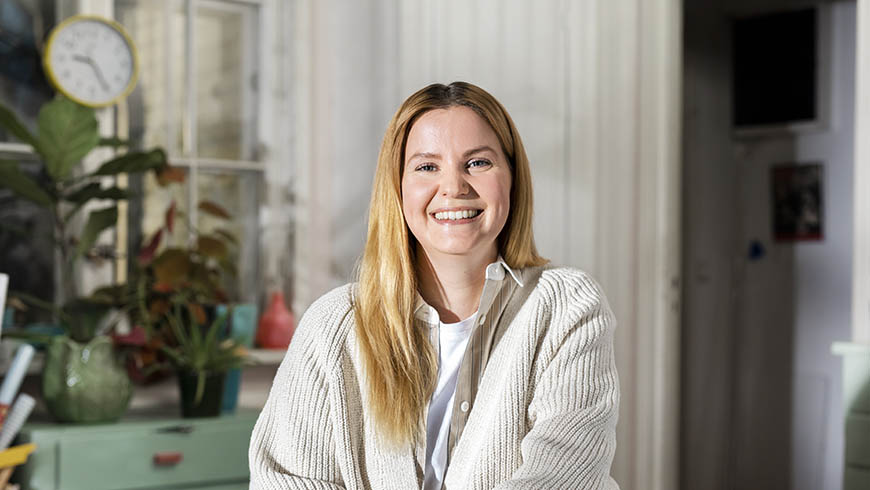
In orthodontic treatment with Invisalign, teeth are straightened using transparent, removable plastic aligners.
The Invisalign method can be used to correct both minor cosmetic issues and more extensive functional malocclusion. An appointment with an orthodontic specialist will give you an overall picture of your occlusion and whether Invisalign could suit your needs.
What is Invisalign?
The Invisalign treatment does not use the typical metal fastenings or wires often associated with orthodontic treatment. The alignment is carried out by an invisible membrane placed on top of the teeth. The membranes are replaced regularly to promote the alignment process.
Invisalign is an easy, unnoticeable orthodontic treatment, and studies show that patients consider the membranes more comfortable than traditional metal braces.
How to start Invisalign treatment?
The best type of treatment is assessed on the first appointment. You can book the first appointment with a dentist who will consult or refer you to an orthodontist, but it is easier to directly book an appointment with an orthodontic specialist.
Any orthodontic treatment at Hammas Mehiläinen is planned carefully as Invisalign treatment may also have side effects. Incorrect treatment may cause functional malocclusion, pain and jaw joint issues.
Invisalign methods for various needs
Invisalign Go for dentists
• Suited for minor or medium cosmetic procedures
• Treatment lasts from a few months to about a year
• The dentist performs the treatment and can consult Mehiläinen’s orthodontist, if necessary.
• Price EUR 2,000–3,000
Invisalign series for orthodontists
(Invisalign Comprehensive, Invisalign Lite, Invisalign Express, Invisalign Teen)
• Suited for treating severe malocclusion
• Treatment lasts from a few months to 18 months
• An orthodontist plans and performs the treatment
• Price EUR 3,000–7,000
What happens in the Invisalign treatment
The right type of treatment is selected on the first appointment. The customer is referred to a specialist, if necessary.
On the next appointment, the teeth and the occlusion are scanned with a 3D scanner. A small camera connected to a computer scans each side of the teeth. After the scanning, which takes about 10–15 minutes, the software creates a treatment plan and the suitable Invisalign membranes are ordered. In the Invisalign series for orthodontists, the orthodontist prepares an individual treatment plan.
Once the membranes are prepared, the dentist shows the customer how to use them. To ensure that the membranes are properly fastened and allow the desired movement in the mouth, an attachment is prepared on some of the teeth. In practice, the attachment is a small, unnoticeable piece of fastening agent. The attachments are removed at the end of the treatment.
The membranes are replaced every week or two as the alignment of the teeth improves. At the beginning of the treatment, the customer may visit the dentist more often to check the progress of the treatment, but the appointments are planned individually. Shaving between the teeth may also be necessary when treating congestion and malocclusion.
How to use and clean the Invisalign membranes
The membranes may feel strange at first, but customers usually get used to them in a day or two. Studies show that users tend to find the membranes more comfortable than traditional, fixed braces.
The Invisalign membranes should be used about 20 hours per day. They are removed when eating and brushing your teeth. The membranes are also washed whenever you brush your teeth. As the membranes are made of plastic, they should be washed with dish soap or regular soap instead of toothpaste.
You should brush your teeth and wash the membranes after each meal. If this is difficult during the day, a good rinse and a quick floss will be sufficient. During the Invisalign treatment, proper oral hygiene is particularly important as the membranes may collect food debris, increasing the risk of cavities. Any new cavities in the teeth must be carefully monitored during the treatment.
Follow-up treatment
Once the orthodontic treatment is finished, the customer starts a follow-up phase as the teeth will try to return to their original position. The follow-up treatment can be implemented with a nighttime dental guard or a wire retainer placed on the inner surface of the teeth.
The follow-up treatment must be continued for as long as the customer wishes the results to remain. Without follow-up treatment, there is always the risk of the teeth returning to their original position.
Orthodontic treatment always carried out by a specialist at Hammas Mehiläinen
It is extremely important to thoroughly plan the treatment as incorrect membrane treatment can cause malocclusion, pain, difficulty eating, headaches and gum recession. Incorrect treatment may call for entirely new treatment or, at worst, maxillofacial surgery. That is why the treatment is always planned by an orthodontist or a dentist consulting an orthodontist at Hammas Mehiläinen. Support from an orthodontist makes the dentist’s treatment safer and improves the results.
Interested in Invisalign? Book an appointment in the Hammas Mehiläinen booking system or by calling us: +358 (0)10 273 8000.
The specialist for the article was Orthodontic Specialist and Doctor of Dentistry Susanna Karsila.